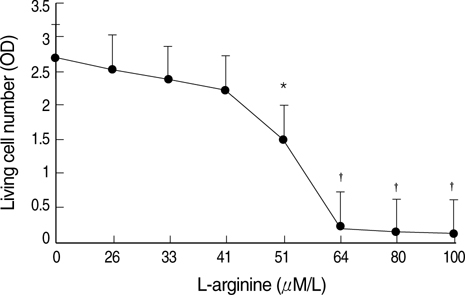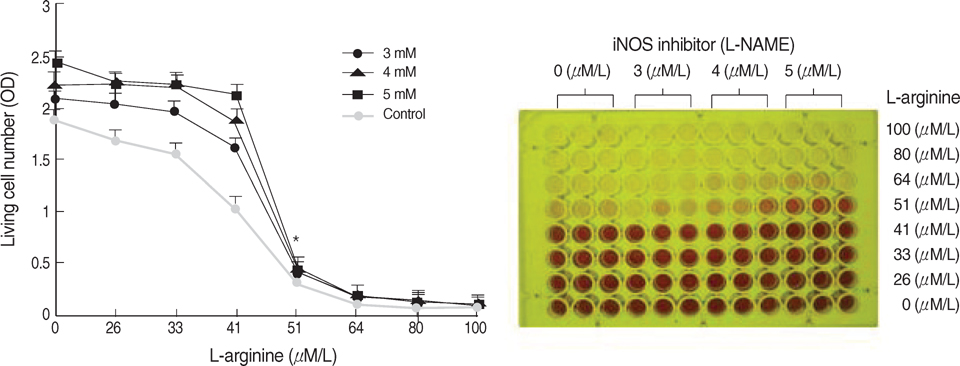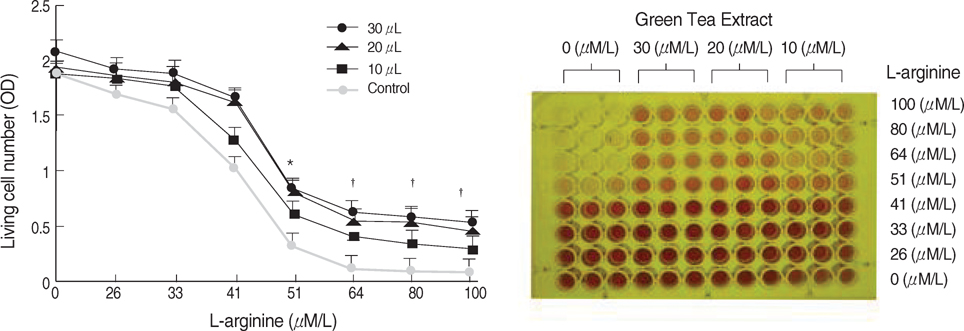J Korean Med Sci.
2009 Jan;24(Suppl 1):S204-S209. 10.3346/jkms.2009.24.S1.S204.
The Protective Effects of Green Tea Extract against L-arginine Toxicity to Cultured Human Mesangial Cells
- Affiliations
-
- 1Department of Internal Medicine, Seonam University College of Medicine, Gwangju, Korea.
- 2Department of Emergency Medicine, Chonnam National University Hospital, Gwangju, Korea.
- 3Department of Internal Medicine, Chosun University College of Medicine, Gwangju, Korea. hyunkim@chosun.ac.kr
- 4Department of Biochemistry, Chosun University College of Medicine, Gwangju, Korea.
- KMID: 1778163
- DOI: http://doi.org/10.3346/jkms.2009.24.S1.S204
Abstract
- The aim of this study was to investigate whether green tea extract (GTE) has the protective effects on excess L-arginine induced toxicity in human mesangial cell. Human mesangial cells treated with L-arginine were cultured on Dulbecco's modified eagle medium in the presence and absence of inducible nitric oxide synthase (iNOS) inhibitor and GTE. The cell proliferation was determined by 3 (4,5-dimethylthiazol- 2-yl)-2, 5-diphengltetrqzolium bromide, a tetrazole assay. The iNOS mRNA and its protein expression were detected by reverse transcription polymerase chain reaction and Western blot, respectively. The concentration of nitric oxide (NO) was measured by NO enzyme-linced immuno sorbent assay kit. L-arginine significantly inhibited the proliferation of human mesangial cells, and induced the secretion of NO to the media. NO production by L-arginine was significantly suppressed by GTE and iNOS inhibitor (p<0.01). The expression level of iNOS mRNA and its protein that was significantly increased by L-arginine was decreased by iNOS inhibitor but not by GTE. GTE protected the mesangial cells from the NO-mediated cytotoxicity by scavenging the NO rather than by iNOS gene expression. Therefore, we conclude that GTE has some protective effect for renal cells against oxidative injury possibly by polyphenols contained in GTE.
Keyword
MeSH Terms
-
Antioxidants/metabolism
Arginine/metabolism/pharmacology/*toxicity
Cell Line
Cell Proliferation
Cell Survival
Flavonoids/metabolism
Glomerular Mesangium/cytology/metabolism
Humans
Mesangial Cells/*cytology/metabolism
Nitric Oxide/chemistry/metabolism
Nitric Oxide Synthase Type II/metabolism
Phenols/metabolism
RNA, Messenger/metabolism
Reverse Transcriptase Polymerase Chain Reaction
Tea
Figure
Reference
-
1. Visek WJ. Arginine needs physiological state and usual diets. A reevaluation. J Nutr. 1986. 116:34–46.
Article2. Natelson S, Sherwin JE. Proposed mechanism for urea nitrogen reutilization: relationship between urea and proposed guanidine cycles. Clin Chem. 1979. 25:1343–1344.
Article3. Ito S, Ren Y. Evidence for the role of nitric oxide in the macula densa control of glomerular hemodynamics. J Clin Invest. 1993. 92:1093–1098.4. Radermacher J, Klanke B, Schurek HJ, Stolte HF, Frolich JC. Importance of NO/EDRF for glomerular and tubular function: studies in the isolated perfused rat kidney. Kidney Int. 1992. 41:1549–1559.
Article5. Shultz PJ, Schorer AE, Raij L. Effects of endothelium-derived relaxing factor on rat mesangial cells. Am J physiol. 1990. 258:F162–F167.6. Raij L, Shultz PJ. Endothelium-derived relaxing factor, nitric oxide: Effects on and production of mesangial cell and glomerulus. J Am Soc Nephrol. 1993. 3:1435–1441.7. Orita Y, Tsubakihara Y, Ando A, Nakata K, Takamitsu Y, Fukuhara Y, Abe H. Effect of arginine or creatinine administration on urinary excretion of methylguanidine. Nephron. 1978. 22:328–336.8. Paller MS, Hoidal JR, Ferris TF. Oxygen free radicals in ischemic acute renal failure in the rat. J Clin Invest. 1984. 74:1156–1164.
Article9. Mohamadin AM, El-Beshbishy HA, El-Mahdy MA. Green tea extract attenuates cyclosporine A-induced oxidative stress in rats. Pharmacol Res. 2005. 51:51–57.
Article10. Jung YD, Kim MS, Shin BA, Chay KO, Ahn BW, Liu W, Bucana CD, Gallick GE, Ellis LM. EGCG, a major component of green tea, inhibits tumor growth by inhibiting VEGF induction in human colon carcinoma cells. Br J Cancer. 2001. 84:844–850.11. Tsubono Y, Nishino Y, Komatsu S, Hsieh CC, Kanemura S, Tsuji I, Nakatsuka H, Fukao A, Satoh H, Hisamichi S. Green tea and the risk of gastric cancer in Japan. N Engl J Med. 2001. 344:632–636.
Article12. Ji BT, Chow WH, Hsing AW, McLaughlin JK, Dai Q, Gao YT, Blot WJ, Fraumeni JF Jr. Green tea consumption and the risk of pancreas and colorectal cancer. Int J Cancer. 1997. 70:225–258.13. Maity S, Vedasiromoni JR, Ganguly DK. Role of glutathione in the antiulcer effect of hot water extract of black tea (Camellia sinensis). Jpn J Pharmacol. 1998. 78:285–292.
Article14. Cortas NK, Wakid NW. Determination of inorganic nitrate in serum and urine by a kinetic cadmium reduction method. Clin Chem. 1990. 36:1440–1443.15. Zhang Q, Kelly AP, Wang L, French SW, Tang X, Duong HS, Messadi DV, Le AD. Green tea extract and (-)-epigallocatechin-3-gallate inhibit mast cell-stimulated type I collagen expression in keloid fibroblasts via blocking PI-3K/AkT signaling pathways. J Invest Dermatol. 2006. 126:2607–2613.
Article16. Morrisey JJ, Ishidoya S, McCracken R, Klahr S. Nitric oxide generation ameliorates the tubulointerstitial fibrosis of obstructive nephropathy. J Am Soc Nephrol. 1996. 7:2202–2212.17. Shi SH, Zheng SS, Xie HY. Tea polyphenols protect against cyclosporine-induced acute nephrotoxicity in rats. Chin J Organ Transplant. 2001. 22:271–273.18. Choi JH, Chang HW, Rhee SJ. Effect of green tea catechin on arachidonic acid cascade in chronic cadmium-poisoned rats. Asia Pac J Clin Nutr. 2002. 11:292–297.
Article19. Giachelli CM, Pichler R, Lombardi D, Denhardt DT, Alpers CE, Schwartz SM, Johnson RJ. Osteopontin expression in angiotensin II-induced tubulointerstitial nephritis. Kidney Int. 1994. 45:515–524.
Article20. Liu BC, Ma KL, Ye YY, Liu NF, Ruan XZ. Effects of L-arginine on proliferation of human renal mesangial cells and production of extracellular matrix. Acta Pharmacol Sin. 2001. 22:756–760.21. Noris M, Benigni A, Boccardo P, Aiello S, Gaspari F, Todeschini M, Figliuzzi M, Remuzzi G. Enhanced nitric oxide synthesis in uremia: implication for platelet dysfunction and dialysis hypotension. Kidney Int. 1993. 44:445–450.22. Yokozawa T, Dong E, Nakagawa T, Kashiwagi H, Nakagawa H, Takeuchi S, Chung HY. In vitro and in vivo studies on the radical-scavenging activity of tea. J Agric Food Chem. 1998. 46:2143–2150.
Article23. Yokozawa T, Cho EJ, Nakagawa T. Influence of green tea polyphenol in rats with arginine-induced renal failure. J Agric Food Chem. 2003. 51:2421–2425.
Article
- Full Text Links
- Actions
-
Cited
- CITED
-
- Close
- Share
- Similar articles
-
- Antimicrobial effects of green tea extract-containing dentifrice
- Human Skin Safety Test of Green Tea Cell Extracts in Condition of Allergic Contact Dermatitis
- Effects of Green Tea on Weight Gain, Plasma and Liver Lipids and Lipid Peroxidation in Pair Fed Rats
- Effects of Green tea (-)-epigallocatechin-3-gallate and Polyphenol on the Proliferation and Apoptosis of Cultured Human Keratinocytes, Melanocytes, Fibroblasts, Endothelial Cells, and Human Epidermoid Carcinoma Cells
- Transactivation of peroxisome proliferator-activated receptor alpha by green tea extracts






